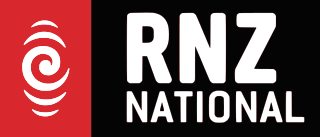Related Research Articles

Medium wave (MW) is a part of the medium frequency (MF) radio band used mainly for AM radio broadcasting. The spectrum provides about 120 channels with more limited sound quality than FM stations on the FM broadcast band. During the daytime, reception is usually limited to more local stations, though this is dependent on the signal conditions and quality of radio receiver used. Improved signal propagation at night allows the reception of much longer distance signals. This can cause increased interference because on most channels multiple transmitters operate simultaneously worldwide. In addition, amplitude modulation (AM) is often more prone to interference by various electronic devices, especially power supplies and computers. Strong transmitters cover larger areas than on the FM broadcast band but require more energy and longer antennas. Digital modes are possible but have not reached momentum yet.

AM broadcasting is radio broadcasting using amplitude modulation (AM) transmissions. It was the first method developed for making audio radio transmissions, and is still used worldwide, primarily for medium wave transmissions, but also on the longwave and shortwave radio bands.
C-QUAM is the method of AM stereo broadcasting used in Canada, the United States and most other countries. It was invented in 1977 by Norman Parker, Francis Hilbert, and Yoshio Sakaie, and published in an IEEE journal.

Monaural sound or monophonic sound is sound intended to be heard as if it were emanating from one position. This contrasts with stereophonic sound or stereo, which uses two separate audio channels to reproduce sound from two microphones on the right and left side, which is reproduced with two separate loudspeakers to give a sense of the direction of sound sources. In mono, only one loudspeaker is necessary, but, when played through multiple loudspeakers or headphones, identical signals are fed to each speaker, resulting in the perception of one-channel sound "imaging" in one sonic space between the speakers. Monaural recordings, like stereo ones, typically use multiple microphones fed into multiple channels on a recording console, but each channel is "panned" to the center. In the final stage, the various center-panned signal paths are usually mixed down to two identical tracks, which, because they are identical, are perceived upon playback as representing a single unified signal at a single place in the soundstage. In some cases, multitrack sources are mixed to a one-track tape, thus becoming one signal. In the mastering stage, particularly in the days of mono records, the one- or two-track mono master tape was then transferred to a one-track lathe used to produce a master disc intended to be used in the pressing of a monophonic record. Today, however, monaural recordings are usually mastered to be played on stereo and multi-track formats, yet retain their center-panned mono soundstage characteristics.
Simulcast is the broadcasting of programs or events across more than one resolution, bitrate or medium, or more than one service on the same medium, at exactly the same time. For example, Absolute Radio is simulcast on both AM and on satellite radio. Likewise, the BBC's Prom concerts were formerly simulcast on both BBC Radio 3 and BBC Television. Another application is the transmission of the original-language soundtrack of movies or TV series over local or Internet radio, with the television broadcast having been dubbed into a local language.
AM stereo is a term given to a series of mutually incompatible techniques for radio broadcasting stereo audio in the AM band in a manner that is compatible with standard AM receivers. There are two main classes of systems: independent sideband (ISB) systems, promoted principally by American broadcast engineer Leonard R. Kahn; and quadrature amplitude modulation (QAM) multiplexing systems.

RNZ National, formerly Radio New Zealand National, and known until 2007 as the National Programme or National Radio, is a publicly funded non-commercial New Zealand English-language radio network operated by Radio New Zealand. It specialises in programmes dedicated to news, the arts, music, and New Zealand culture generally, and includes some material in the Māori language. Historically the programme was broadcast on the (AM) "YA" stations 1YA, 2YA, 3YA and 4YA in the main centres.

WBLK is a commercial radio station licensed to Depew that serves Western New York, the Buffalo metropolitan area and the Niagara Region of Ontario. WBLK is owned by Townsquare Media and has an urban contemporary radio format, featuring hip hop, R&B and soul. The station carries the syndicated Steve Harvey Morning Show.

Stereophonic sound, or more commonly stereo, is a method of sound reproduction that recreates a multi-directional, 3-dimensional audible perspective. This is usually achieved by using two independent audio channels through a configuration of two loudspeakers in such a way as to create the impression of sound heard from various directions, as in natural hearing.

FM broadcasting is a method of radio broadcasting that uses frequency modulation (FM) of the radio broadcast carrier wave. Invented in 1933 by American engineer Edwin Armstrong, wide-band FM is used worldwide to transmit high-fidelity sound over broadcast radio. FM broadcasting offers higher fidelity—more accurate reproduction of the original program sound—than other broadcasting techniques, such as AM broadcasting. It is also less susceptible to common forms of interference, having less static and popping sounds than are often heard on AM. Therefore, FM is used for most broadcasts of music and general audio. FM radio stations use the very high frequency range of radio frequencies.
WCRB is a non-commercial radio station licensed to Lowell, Massachusetts, which serves the Greater Boston area. It broadcasts classical music. The station's studios are located in Brighton, and its transmitter is located west of Andover.

WRAW is a commercial AM radio station licensed to Reading, Pennsylvania. The station is owned by iHeartMedia and calls itself "Newsradio 1340 WRAW." It broadcasts a conservative talk radio format.

KHVH is a commercial AM radio station in Honolulu, Hawaii. It broadcasts a news/talk format and is owned by iHeartMedia, Inc. Its studios and offices are on Iwilei Road in the Kalihi neighborhood of Honolulu.

WCOS-FM is a commercial radio station in Columbia, South Carolina. It airs a country music radio format and is owned by iHeartMedia, Inc. The station goes by the name 97-5 WCOS and its current slogan is "#1 For New Country". Its studios and offices are on Graystone Boulevard in Columbia near Interstate 126.

WOOD-FM is a commercial radio station licensed to Muskegon, Michigan, serving West Michigan and is owned by iHeartMedia, Inc. It simulcasts a news/talk radio format with sister station WOOD 1300 AM. The studios and offices are at 77 Monroe Center in Downtown Grand Rapids. Following a local weekday drive time show, "West Michigan's Morning News", the station carries nationally syndicated talk shows from Sean Hannity, Glenn Beck, Dave Ramsey, Joe Pags, "The Clay Travis and Buck Sexton Show" and "Coast to Coast AM with George Noory". Most hours begin with an update from Fox News Radio.

WTKG is a radio station broadcasting a news/talk/sports format consisting of news and sports. Licensed to Grand Rapids, Michigan, United States, and now owned by iHeartMedia, Inc., Previous to adopting the current calls and format in 1997, the station played country under the WJEF and WCUZ calls.

WMXY is a commercial radio station in Youngstown, Ohio. It broadcasts a mainstream adult contemporary radio format and switches to all-Christmas music for much of November and December. WMXY is owned by iHeartMedia, Inc. It is the Youngstown network affiliate for the Delilah syndicated music and call-in show in the evening, and carries the Ellen K Weekend Show Saturdays and Casey Kasem's classic American Top 40 on Sundays.
Copies of the World Radio TV Handbook have identified 1485 kHz as a local frequency, akin to the Class C radio stations in North America which are limited to 1kW.
The following radio stations broadcast on AM frequency 1098 kHz.
References
- ↑ List of A.M. Stereo stations on the website meduci.com
- ↑ "Radio Rewind - Radio 1 History - Transmitters". www.radiorewind.co.uk. Retrieved 2024-04-08.